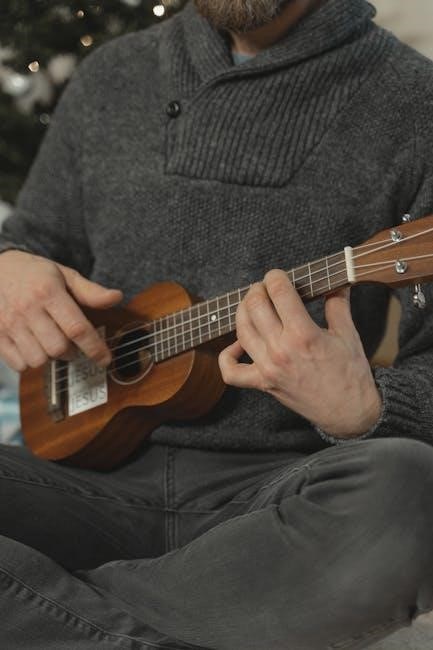Title: How to Play “Riptide” on Ukulele: A Comprehensive Guide with Chords and Tabs
This comprehensive guide provides detailed ukulele chords and tabs for “Riptide” by Vance Joy, along with resources for downloading free PDF chord sheets and tabs․
“Riptide” by Vance Joy is a beloved ukulele song due to its catchy melody and simple chords․ Using Am, G, C, and F, it’s accessible for beginners․ The song’s structure allows for creative variations like chord inversions and suspended chords, enhancing playfulness․ Doctor Uke and Ukulele Wednesdays offer free PDF chord sheets, aiding learners․ Its popularity endures as a favorite in ukulele communities, promoting both education and enjoyment worldwide․ This versatility makes it a staple for many players, fostering a sense of accomplishment and musical growth․
Understanding the Basic Chords Required for “Riptide”
The song primarily uses Am, G, C, and F chords, which are simple for beginners to learn and provide a solid foundation for playing “Riptide” smoothly․
2․1 List of Chords: Am, G, C, F
The essential chords for “Riptide” are Am, G, C, and F․ These chords are straightforward for beginners and form the backbone of the song․ The Am chord provides a melancholic tone, while G and C add progression․ The F chord is used sparingly but adds depth․ Mastering these chords will allow you to play the song smoothly․ Practice transitioning between them to maintain a consistent rhythm and flow during performance․ This set of chords is repeated throughout the song, making them foundational for learning “Riptide” on the ukulele․
2․2 Simple Chord Shapes for Beginners
Beginners can master “Riptide” with simple chord shapes․ The Am chord uses fingers on the 1st and 2nd frets of the G and C strings․ G chord is played with fingers on the 2nd and 3rd frets of the C and A strings․ C chord requires placing fingers on the 3rd fret of the A string and open C and E strings․ F chord involves barring the 1st fret and placing fingers on the 2nd and 3rd frets․ These shapes are foundational and easy to learn, allowing smooth transitions between chords during the song․
Breaking Down the Song Structure
The song structure of “Riptide” includes verses, pre-chorus, chorus, bridge, and outro, each with its own chord progressions and rhythmic patterns, contributing to its catchy and memorable flow․
3․1 Intro and Verse Chord Progression
The song begins with a simple yet iconic chord progression using Am, G, C, and F․ The intro and verses follow a repeating pattern of Am-G-C-C, creating a smooth and recognizable flow․ This progression is easy to follow and sets the foundation for the song’s melody․ Strumming down on each chord with a steady rhythm brings the verses to life, making it accessible for beginners to learn and play along with the tabs provided in the PDF guides․
3․2 Pre-Chorus and Chorus Chord Progression
The pre-chorus transitions smoothly with an Am-G-F-C pattern, building momentum before reaching the chorus․ The chorus uses the same core chords—Am, G, C, and F—but with a stronger emphasis on rhythm and strumming․ The progression Am-G-C-F repeats, creating a catchy and memorable melody․ This structure is consistent across most arrangements and is clearly outlined in the PDF chord sheets, making it easy to follow and play along with Vance Joy’s original version․
3․3 Bridge and Outro Chord Progression
The bridge of “Riptide” maintains the core Am-G-C-F progression but adds a slight variation with suspended chords for depth․ It transitions seamlessly into the outro, which mirrors the chorus’s chord structure but with a slower, more reflective strumming pattern․ The outro resolves with an Am-G repetition, creating a satisfying conclusion․ These progressions are clearly detailed in the PDF chord sheets, ensuring accuracy and ease of play for all skill levels․
Strumming Patterns and Fingerpicking Techniques
Master the basic down-up strumming pattern and explore fingerpicking techniques to enhance your ukulele playing․ These methods are detailed in the PDF chord sheets for “Riptide․”
4;1 Basic Down-Up Strumming Pattern
The basic down-up strumming pattern is essential for playing “Riptide” on the ukulele․ Start with a downstroke on the beat and an upstroke on the off-beat, creating a smooth rhythm․ This pattern works well with the Am, G, C, and F chords, providing a steady flow․ Practice this technique to maintain consistency and timing, as it forms the foundation of the song’s feel․ Tutorials often emphasize this pattern for beginners to build confidence in their strumming․
4․2 Advanced Fingerpicking Patterns
For intermediate players, advanced fingerpicking patterns can enhance the emotional depth of “Riptide․” Use thumb and fingers to create intricate rhythms․ Start with a basic arpeggio pattern, then incorporate alternating bass lines․ Experiment with suspended chords to add texture․ This technique brings complexity to the song while maintaining its melodic flow․ Practice finger independence to achieve a smooth, dynamic sound that elevates your performance beyond basic strumming․
Tips for Beginners Learning “Riptide” on Ukulele
Beginners should focus on smooth chord transitions and maintaining a steady rhythm․ Practice switching between Am, G, C, and F chords regularly․ Use chord inversions for a fuller sound and explore free PDF resources like Doctor Uke for accurate tabs and chord sheets to guide your learning journey effectively․
5․1 Practicing Chord Transitions Smoothly
Focus on smooth transitions between chords Am, G, C, and F․ Practice switching chords slowly to build muscle memory․ Use a metronome to improve timing․ Break the song into smaller sections to master transitions between verses and choruses․ Regular practice will help you play seamlessly, ensuring a polished performance of “Riptide․” Utilize chord sheets from Doctor Uke to guide your practice effectively and enhance your learning experience․
5․2 Maintaining a Steady Rhythm
Keeping a steady rhythm is crucial for playing “Riptide” smoothly․ Use a metronome to practice consistent timing․ Focus on down-up strumming patterns, emphasizing beats 1 and 3․ Break the song into sections to master rhythm gradually․ Start slowly and increase speed as confidence grows․ Pay attention to syncopation, especially in the chorus․ Practice with chord sheets from Doctor Uke to ensure accuracy and maintain a steady rhythm throughout the song․
Variations and Inversions to Enhance Your Playing
Explore chord inversions and suspended chords to add depth․ Try Am, G, C, and F with variations for a richer sound․ Adding suspended chords like Csus2 creates a modern feel, enhancing “Riptide’s” appeal․ Experiment with these techniques to personalize your playing․ Find detailed variations in Doctor Uke’s free PDF chord sheets for inspiration․
6․1 Using Chord Inversions for a Fuller Sound
Chord inversions can enhance the sound of “Riptide” by creating smoother transitions and a richer harmonic texture․ For example, playing an inverted Am (with the high note on the G string) or a inverted G (with the high note on the C string) adds depth․ Experiment with these variations to add complexity while maintaining the song’s original feel․ Doctor Uke’s PDFs often include inversion suggestions for a fuller sound․
6․2 Adding Suspended Chords for a Modern Feel
Adding suspended chords like Csus2 or Gsus4 can give “Riptide” a modern, dynamic feel․ These chords replace the third with a suspension, creating a bright, open sound․ Try substituting standard chords in the pre-chorus or bridge for a fresh twist․ Vance Joy’s original version hints at this, and Doctor Uke’s PDFs often include sus chords for added depth․ Experiment with these to enhance the song’s contemporary vibe while maintaining its essence․
Resources for Downloading “Riptide” Ukulele Chords PDF
Download free “Riptide” ukulele chords and tabs from trusted sources like Doctor Uke and Ukulele Wednesdays․ These websites offer printable PDFs with accurate chords, tabs, and lyrics․
7․1 Recommended Websites for Ukulele Chord Sheets
For reliable ukulele chord sheets, visit Doctor Uke and Ukulele Wednesdays․ Doctor Uke offers extensive chord charts and tabs for “Riptide,” ideal for students and enthusiasts․ Ukulele Wednesdays provides a comprehensive songbook with accurate chords and lyrics, perfect for group jams․ Both sites ensure high-quality, printable PDFs, making it easy to learn and play “Riptide” on your ukulele with precision and confidence․
7․2 Free Printable PDFs from Doctor Uke
Doctor Uke offers free, high-quality printable PDFs for “Riptide,” including chords, tabs, and lyrics․ These PDFs are designed for educational use, featuring clear layouts and accurate arrangements․ They cover the entire song, from the intro to the outro, making it easy to follow and practice․ Visit Doctor Uke’s website to download and print these resources, perfect for learning and mastering “Riptide” on your ukulele․

Background Information on Vance Joy and the Song
Vance Joy is an Australian singer-songwriter known for his heartfelt, acoustic-driven music․ “Riptide,” released in 2013, became his breakout hit, featuring simple yet catchy ukulele-friendly chords like Am, G, C, and F, making it a favorite for ukulele players worldwide․
8․1 The Story Behind “Riptide” and Its Success
“Riptide,” written by Vance Joy, was released in 2013 and quickly became a global hit․ Its success stems from its catchy, acoustic-driven melody and relatable lyrics․ The song’s simple chord structure, featuring Am, G, C, and F, made it accessible for ukulele players, contributing to its viral popularity․ Its emotional depth and Joy’s raw, heartfelt delivery resonated with listeners worldwide, solidifying its place as a modern classic in indie-pop music․
8․2 Vance Joy’s Musical Style and Influence
Vance Joy’s music is known for its heartfelt, acoustic-driven sound and introspective lyrics․ His style blends indie, folk, and pop elements, creating a unique and relatable sound․ Joy’s simplicity in chord progressions, as seen in “Riptide,” has made his songs accessible to ukulele players worldwide․ His authenticity and emotional delivery have solidified his influence in the indie-pop genre, inspiring countless musicians and fans alike․
Common Mistakes to Avoid When Playing “Riptide”
Common mistakes include chord muting, buzzing strings, and inconsistent tempo․ Ensure smooth transitions and clear strums to maintain the song’s rhythm and melody effectively while playing․
9․1 Avoiding Chord Muting and Buzzing Strings
Chord muting and buzzing strings are common issues when playing “Riptide․” These occur when fingers press multiple strings or don’t press firmly enough․ To avoid this, practice basic chord shapes and ensure fingers are placed correctly․ Using the pads of your fingers and maintaining a proper ukulele hold can help prevent muting and buzzing, ensuring clear and smooth chord transitions․
9․2 Keeping the Tempo Consistent
Keeping the tempo consistent is crucial for playing “Riptide” smoothly․ Use a metronome to practice at a steady pace, starting slowly and increasing speed as confidence grows․ Focus on counting aloud to internalize the rhythm․ Emphasize downbeats to maintain structure, ensuring verses, choruses, and bridges align seamlessly․ Avoid rushing or dragging by staying mindful of the song’s natural flow, which will enhance overall performance and make the track more enjoyable to play and listen to․

Advanced Techniques for Intermediate Players
Incorporate barre chords for richer tones, add harmonics for a brighter sound, and experiment with percussive elements like strumming patterns to elevate your “Riptide” performance dynamically․
10․1 Incorporating Barre Chords
Incorporating barre chords into “Riptide” enhances the song’s depth and complexity․ Intermediate players can substitute standard chords with barre versions of Am, G, and C for a richer sound․ Barre chords allow for smoother transitions and a more dynamic performance․ Practice sliding barre chords up and down the neck to create intricate melodies․ This technique adds a professional touch while maintaining the song’s familiar rhythm and structure․ Experiment with barre chord variations to personalize your rendition of “Riptide․”
10․2 Adding Harmonics and Percussive Elements
Enhance your “Riptide” performance by incorporating harmonics and percussive elements․ Harmonics add a bright, ethereal quality, while percussive techniques like tapping or slapping the ukulele body create dynamic rhythm․ Experiment with harmonics on key notes to add depth․ For percussion, try light taps on the body or muted strums for a modern feel․ These advanced techniques make your rendition unique and engaging, offering a fresh twist to the original melody․

How to Play “Riptide” with a Group or Band
Playing “Riptide” with a group or band adds depth and harmony․ Use the main chords Am, G, C, and F, and encourage others to add harmonies or rhythms․
11․1 Collaborating with Other Ukulele Players
Collaborating with other ukulele players enhances the fun and richness of playing “Riptide․” Use the same chord charts and tabs to ensure everyone plays in sync․ Assign different parts, like rhythm and melody, to create a layered sound․ Encourage players to add harmonies or alternate chord voicings for depth․ Practice together to maintain a steady tempo and experiment with group strumming patterns for a cohesive performance․
11․2 Adding Harmonies and Backup Vocals
Adding harmonies and backup vocals to “Riptide” enhances its emotional depth․ Use chord-based harmonies, focusing on thirds and fifths of Am, G, C, and F․ Experiment with layered vocals to create a richer sound․ Ensure harmonies align with the song’s tempo and rhythm․ Practice blending voices to achieve a balanced, cohesive performance that complements the ukulele chords and melody․

The Importance of Practicing with a Metronome
Practicing with a metronome improves timing and syncopation, essential for playing “Riptide” smoothly․ It helps maintain a consistent tempo, enhancing rhythm accuracy and overall performance confidence․
12․1 Improving Timing and Syncopation
Using a metronome helps master the strumming patterns in “Riptide,” ensuring consistent timing and rhythm․ It aids in maintaining a steady tempo, crucial for syncopation and avoiding common mistakes like rushing or dragging․ Regular practice with a metronome enhances rhythm accuracy, allowing players to focus on chord transitions and fingerpicking techniques․ This tool is essential for building confidence and delivering a polished performance of the song․
12․2 Building Confidence in Your Playing
Building confidence in playing “Riptide” on ukulele starts with consistent practice․ Break the song into manageable sections, focusing on smooth chord transitions and steady strumming․ Celebrate small achievements to stay motivated․ Utilize free PDF chord sheets and tabs from reliable sources like Doctor Uke for accurate guidance․ Embrace mistakes as learning opportunities and gradually increase complexity as you progress․ Positive reinforcement and patience will enhance your performance and overall confidence․
Mastering “Riptide” on ukulele is a rewarding journey that combines simple chords with meaningful lyrics․ Consistent practice and patience are key to refining your skills․ Use free PDF chord sheets from trusted sources like Doctor Uke to guide your learning․ Celebrate small milestones, like smooth chord transitions or steady strumming, to build confidence․ Embrace the process, enjoy the music, and remember that practice leads to perfection․ Happy playing!